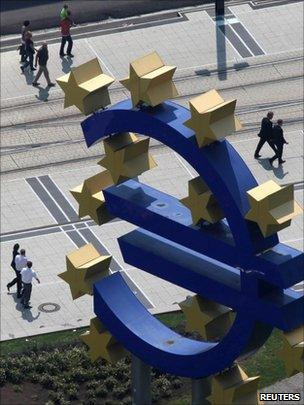How ECB failed to reassure investors
- Published
- comments

Italy has to borrow more than 500 billion euros to repay existing debt
In spite of a series of emergency statements from the European Central Bank, finance ministers of the G7 developed nations, and the IMF, the value of shares in Asia continued their slide of last week and the dollar weakened - and those trends look set to continue when European and US markets open.
On the face of it, the main source of stress in markets may not be the downgrade of US government debt by the ratings agency Standard & Poors, because the price of 10 year government bonds actually rose a bit overnight - which is the reverse of what should happen if investors agreed with S&P that the prospects for the US repaying all its debts have worsened.
That said, there is a peculiar internal contradiction in markets that has been created by S&P's downgrade: on the one hand it should make US government bonds less attractive to own; on the other, for those who still engage in the knee-jerk policy of buying US government bonds and shunning shares when the world seems a riskier place, the downgrade's heightening of perceived risk in the financial world makes US government debt seem more attractive.
Welcome to the surrealism of global market behaviour.
'Mortal wound'
But as I said over the weekend, it is the perceived inadequate response of eurozone governments to the rising borrowing costs of Italy and Spain that is investors' and creditors' more pressing worry.
Last night's statement from the European Central Bank, external implied that it would do what investors say they want it to do, which is to buy Italian and Spanish debt, to make up for inadequate demand from banks and commercial investors.
But the ECB made it clear it would be doing so with extreme reluctance. Also the ECB implied that it would buy Spanish and Italian bonds only until eurozone governments have ratified a rescue package for their currency union that was agreed on 21 July, which would allow their bailout fund - the European Financial Stability Facility - to buy the debt of eurozone members facing funding difficulties.
Although France and Germany insisted in a joint statement that their parliaments would ratify the rescue package by the end of September, ratification by all sovereign members can't be taken for granted (the perils of living in a democracy).
And there's another thing which spooks investors: eurozone governments have not done the one thing investors most want, which is to agree to massively increase the size of the EFSF.
Here is the relevant statistic. Over the next five years, Italy has to borrow more than 500 billion euros, simply to repay existing debt that is set to mature. On top of that, Italy will have to borrow more to finance its deficit, the gap between tax revenues and spending.
To put it another way, Italy's potential financing requirements on its own would exhaust the resource of the EFSF, based on its current size, if investors were to shun Italy altogether.
That is why investors see any purchases by the European Central Bank of Spanish and Italian debt as - at best - a sticking plaster. ECB purchases would not provide long-term sustainable demand for Spanish and Italian bonds.
The sticking plaster is only useful if it gives Italy and Spain sufficient time to persuade the markets that they have their deficits on a sustainable downward trend and their public finances are being properly fixed.
But if in the coming weeks Italy and Spain fail to do that, declining confidence in their ability to repay their debts will look even more like a potentially mortal wound for the eurozone.